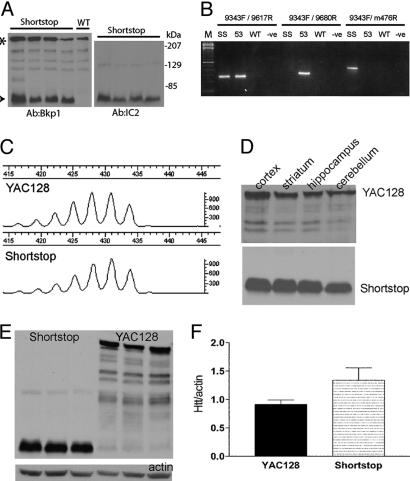Fig. 1.
Characterization of shortstop fragment and comparison with full-length YAC128. (A) Western blot showing protein expression of shortstop fragment (arrowhead) probed with the htt-specific antibody BKP1 and the polyQ-specific antibody 1C2. Full-length, mouse-endogenous htt is shown (asterisk). (B) PCRs on genomic mouse DNA from shortstop (SS), YAC128 (53), and WT mice using primers within intron 2 of human htt before (9343F/9617R) and after (9343F/9680R) the shortstop breakpoint reveal the presence of part of intron 2 in shortstop. PCRs with primers from human intron 2 (9343F) and mouse chromosome 4 (m476R) reveal a band in shortstop, indicating integration into mouse chromosome 4. (C) Fragment analysis of PCR products amplified by using human-specific primers that border the CAG tract (including 69 bp of flanking sequence) demonstrate identical CAG size in YAC128 and shortstop mice. (D) Western blots with 1C2 show similar protein expression in shortstop and YAC128 mice across brain regions. (E) Western blots with 1C2 show similar levels of transgenic protein in shortstop and YAC128 cortex (n = 3). (F) Accompanying densitometry analysis of a shorter exposure of blot in E (in the linear range of detection) reveals that shortstop mice express 1.46 times the protein of YAC128 mice.

